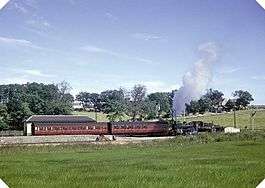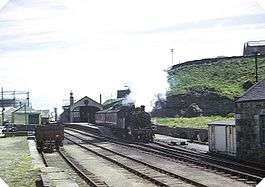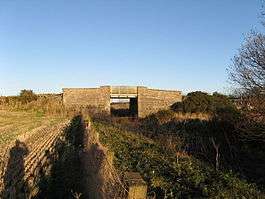Banff, Portsoy and Strathisla Railway
The Banff, Portsoy and Strathisla Railway, later known as the Banffshire Railway, connected the Aberdeenshire ports of Banff and Portsoy with the Great North of Scotland Railway's (GNSR) main line at Grange. The railway opened in 1859, and was renamed the Banffshire in 1863 when the GNSR began running services. The railway was merged with the GNSR on 12 August 1867.
| Banff, Portsoy and Strathisla Railway | |||||||||||||||||||||||||||||||||||||||||||||||||||||||||||||||||||||||||||||||||||||||||||||||||||||||||||||||||||||||||||||||||||||||||||||||||||||||||||||||
|---|---|---|---|---|---|---|---|---|---|---|---|---|---|---|---|---|---|---|---|---|---|---|---|---|---|---|---|---|---|---|---|---|---|---|---|---|---|---|---|---|---|---|---|---|---|---|---|---|---|---|---|---|---|---|---|---|---|---|---|---|---|---|---|---|---|---|---|---|---|---|---|---|---|---|---|---|---|---|---|---|---|---|---|---|---|---|---|---|---|---|---|---|---|---|---|---|---|---|---|---|---|---|---|---|---|---|---|---|---|---|---|---|---|---|---|---|---|---|---|---|---|---|---|---|---|---|---|---|---|---|---|---|---|---|---|---|---|---|---|---|---|---|---|---|---|---|---|---|---|---|---|---|---|---|---|---|---|---|---|
| Overview | |||||||||||||||||||||||||||||||||||||||||||||||||||||||||||||||||||||||||||||||||||||||||||||||||||||||||||||||||||||||||||||||||||||||||||||||||||||||||||||||
| Locale | Scotland | ||||||||||||||||||||||||||||||||||||||||||||||||||||||||||||||||||||||||||||||||||||||||||||||||||||||||||||||||||||||||||||||||||||||||||||||||||||||||||||||
| Operation | |||||||||||||||||||||||||||||||||||||||||||||||||||||||||||||||||||||||||||||||||||||||||||||||||||||||||||||||||||||||||||||||||||||||||||||||||||||||||||||||
| Opened | 1859 | ||||||||||||||||||||||||||||||||||||||||||||||||||||||||||||||||||||||||||||||||||||||||||||||||||||||||||||||||||||||||||||||||||||||||||||||||||||||||||||||
| Closed | 1968 | ||||||||||||||||||||||||||||||||||||||||||||||||||||||||||||||||||||||||||||||||||||||||||||||||||||||||||||||||||||||||||||||||||||||||||||||||||||||||||||||
| Events | |||||||||||||||||||||||||||||||||||||||||||||||||||||||||||||||||||||||||||||||||||||||||||||||||||||||||||||||||||||||||||||||||||||||||||||||||||||||||||||||
| Successor line | Great North of Scotland Railway | ||||||||||||||||||||||||||||||||||||||||||||||||||||||||||||||||||||||||||||||||||||||||||||||||||||||||||||||||||||||||||||||||||||||||||||||||||||||||||||||
| Technical | |||||||||||||||||||||||||||||||||||||||||||||||||||||||||||||||||||||||||||||||||||||||||||||||||||||||||||||||||||||||||||||||||||||||||||||||||||||||||||||||
| Line length | 19 1⁄2 miles (31.4 km) | ||||||||||||||||||||||||||||||||||||||||||||||||||||||||||||||||||||||||||||||||||||||||||||||||||||||||||||||||||||||||||||||||||||||||||||||||||||||||||||||
| Track gauge | 4 ft 8 1⁄2 in (1,435 mm) | ||||||||||||||||||||||||||||||||||||||||||||||||||||||||||||||||||||||||||||||||||||||||||||||||||||||||||||||||||||||||||||||||||||||||||||||||||||||||||||||
| |||||||||||||||||||||||||||||||||||||||||||||||||||||||||||||||||||||||||||||||||||||||||||||||||||||||||||||||||||||||||||||||||||||||||||||||||||||||||||||||


Before 1886 services ran between Banff and Grange, with connecting services at Tillynaught for Portsoy. However, after the Coast Line opened, the Portsoy branch became part of an alternative route to Elgin, the Banff to Tillynaught becoming the branch. Following the grouping in 1923, the line became part of London and North Eastern Railway and was nationalised, becoming part of British Railways. The Tillynaught to Banff branch closed to passengers on 6 July 1964 and completely on 6 May 1968, and the Coast Line closed completely on 6 May 1968.[1]
Construction
The Great North of Scotland Railway Company (GNSR) was authorised to build the Banff, Portsoy & Strathisla Railway but financial problems prevented them from proceeding. As there was considerable local support for the line a new company, The Banff, Portsoy and Strathisla Railway Company, was formed to build and operate the line.[2] The company directors were mostly business men and local landowners. The line ran for 16¼ miles from Banff to Grange, where it joined the main Aberdeen to Inverness line. There was a further 3¼ miles on a branch from Tillynaught to Portsoy. The engineer appointed to construct the line was Blyth of Edinburgh and work commenced in February 1858. The company was short of money and it was decided in July 1859 to open the line, though at this stage it was far from complete.[2] The main problem encountered in the construction was the severe gradients. The summit of the line was at Glenbarry where the gradient was 1 in 70. The approach to Portsoy harbour from the station was an extreme 1 in 30 where special precautions had to be taken. A single locomotive was limited to 4 wagons on this branch. There were always plans to extend the line along the coast to Buckie but financial problems prevented this happening for many years. By 1861 the company was in debt by £60,000, all of which was the personal liability of the directors. It was considered that the best way out of this difficulty was by way of this expansion. The idea was to invite the GNSR to work the line hoping this company would eventually take over completely and settle The Banff, Portsoy and Strathisla company's debts. To this end the name was changed to The Banffshire Railway. However, the GNSR themselves had heavy financial commitments and declined. They did, however help by taking responsibility for the locomotives, rolling stock and stores. In 1867 GNSR took over completely. The extension was eventually built and opened in 1884 when it became part of the Moray Coast Railway.
Running
Blyth, who organised the construction of the line, was also given the task of negotiating for the locomotives and rolling stock. Orders for these were rather late in being placed for the opening of the line. At the start all they had was one engine and two carriages. This engine was a 0-4-2 tank locomotive and was named Banff. The second engine was the same type and was called Portsoy. The third and fourth engines to be bought were 0-4-2 tender engines named Strathisla and Keith. The early coaches employed were of the 4 wheeled non corridor variety. Later 6 wheeled and then bogie carriages were used. Hawthorn Leslie & Company supplied the locomotives.[3] Orders for carriages were placed with Brown, Marshalls and Co. Ltd. of Birmingham and Messrs Wright also of Birmingham supplied the wagons. On the day the line opened a train consisting of a locomotive and two carriages derailed. At an enquiry it was concluded that the timetable required trains to travel at a speed which was unsafe on track which was not in good condition. A speed limit of 16 m.p.h. had to be imposed and the timetable adjusted.[2] The line encountered many problems in the early years: bridges being washed away, blizzards, floods and unreliable engines to name but a few.[3] This line was the last steam operated line in the north east of Scotland.[4]
Usage
In summer many holidaymakers used the line to visit the Moray Firth resorts. Goods traffic consisted mainly of fish and agricultural produce. For some months in the year there were few goods to be carried as these were seasonal products. There was a reduction in the local population during the life of this railway consequently passenger numbers declined and with the advent of road traffic the line became more and more uneconomic. The Tillynaught to Banff section was closed to passengers in 1964 and the whole line was closed to passengers and freight in 1968.

Current use
Parts of the old line are suitable for walkers. Most of the stations and other buildings have disappeared, though a few of the latter have become private residences.
References
- Vallance 1991, Appendix 3.
- Thomas 1976, pp. 177–183.
- Thomas & Turnock 1989, pp. 176–177.
- Smith 2005, p. 30.
Sources
- Smith, W. A. C. (2005). Grampian's Last Days of Steam. Stenlake Publishing. ISBN 978-1-84033-339-8.CS1 maint: ref=harv (link)
- Thomas, John (1976). Forgotten Railways: Scotland. David & Charles. ISBN 978-0-7153-7185-5.CS1 maint: ref=harv (link)
- Thomas, John; Turnock, David (1 March 1989). The north of Scotland. David St John Thomas. ISBN 978-0-946537-03-7.CS1 maint: ref=harv (link)
- Vallance, H. A. (27 June 1991). Great North of Scotland railway. The History of the Railways of the Scottish Highlands vol 3. David St John Thomas. ISBN 978-0-946537-60-0.CS1 maint: ref=harv (link)